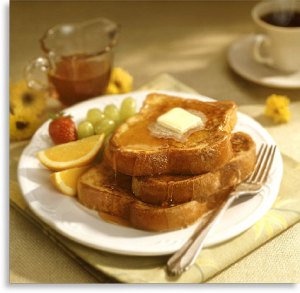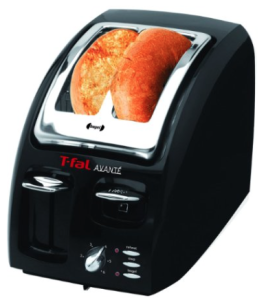A toaster is one of the most common appliances found in kitchens. With the rise of the toaster oven, many people have found it possible to get along without a standalone unit, but for ease of use and the superiority of results, nothing beats a good toaster.
A toaster is any device that’s designed to toast bread. Since the turn of the twentieth century, the word toaster has come to be understood as an appliance that toasts bread inserted vertically between heating elements. The most common type is called a popup toaster, because the machine has a timer that makes the bread pop up when the toasting cycle is complete.
Since toasters only do a few things, they’ve been engineered to do these things very effectively and efficiently. While toasters are designed mostly for toasting rectangular slices of plain bread, they can also handle English muffins, sliced bagels, waffles, and sandwich buns. There are generally only a few controls on a toaster, and operation is as simple as inserting the bread into the slots and pushing down on a lever to drop the bread into the machine, which starts an automatic cycle that ends with the bread popping up out of the appliance when it’s toasted.
The Main Types of Toaster
Two-Slice Pop Up
The most common type of toaster is the electric two-slice pop up toaster. This simple arrangement is the same as the original design invented in 1893 in Scotland, except that the original toaster was unable to brown both sides of the bread at once. Today’s appliances deliver identical results to both sides of the bread at the same time.
Four Slice Toaster
Another popular design for toasters is the four-slice toaster. These units allow the user to use either one or both sides of the toaster at the same time, plus giving the choice between the levels of toasting of two different types of bread at the same time. Since you can use one or both sides of the toaster at the same time, you can use a four-slice toaster as a two-slice toaster if you only need a slice or two, and don’t want to worry about wasting electricity.
 Six-Slice Toasters
Six-Slice Toasters
There are six-slice toasters on the market, but the amount of electricity that’s required to produce six slices at the same time often tests the limit of the electrical circuits in a kitchen, so they have a tendency to be slightly underpowered. Six-slice toasters often produce a lower quality toast than a comparable four-slice toaster, although they do produce it faster.
Conveyor Toasters
After six-slice toasters, the nest step up in capacity is a conveyor toaster. Small restaurants, sandwich shops, bed and breakfasts, summer camps, and other places that need to feed a bunch of people breakfast at the same time can use the conveyor toaster to make up to 900 slices of toast in an hour.
Choose From Many Finishes
 Toasters can be from several materials and finishes. The most popular toasters have a bright chrome finish that stands up well to the high heat and cleans up easily when the meal is over, but they can show fingerprints readily. Stainless steel exteriors have as much durability as chrome, but also tend to show fingerprints more. Stainless steel toasters go well with the many stainless steel appliances that are currently popular in today’s kitchens. Colored plastic is sometimes used for toasters, but the high heat in the toaster has a tendency to make the plastic fade, discolor, or even crack fairly quickly. Some toasters use a combination of stainless steel or chrome along with plastic on the portions of the unit where the operating controls are, which makes keeping fingerprints off the shiny metal surfaces easier.
Toasters can be from several materials and finishes. The most popular toasters have a bright chrome finish that stands up well to the high heat and cleans up easily when the meal is over, but they can show fingerprints readily. Stainless steel exteriors have as much durability as chrome, but also tend to show fingerprints more. Stainless steel toasters go well with the many stainless steel appliances that are currently popular in today’s kitchens. Colored plastic is sometimes used for toasters, but the high heat in the toaster has a tendency to make the plastic fade, discolor, or even crack fairly quickly. Some toasters use a combination of stainless steel or chrome along with plastic on the portions of the unit where the operating controls are, which makes keeping fingerprints off the shiny metal surfaces easier.
All toasters have settings for the amount of browning that you desire. If you always use the toaster to brown the same thickness and type of bread, you’ll have an easy time finding the perfect setting for your needs. Toasting different foods like English muffins or bagels can take a bit of trial and error to find the right settings. If you’re planning on using your toaster mostly for non-standard slices, look for a model that has wider than usual slots that can accommodate them without jamming. If you mostly use thinly sliced breads, you might be disappointed with the uneven results when you toast them in a widely spaced toaster, however.
Special Features to Look For
Even the least expensive toasters do a good job at producing nicely browned bread slices, but there are many more features offered on toasters at different price points that might make one more suitable for your needs:
-
Defrost Setting – While it’s possible to defrost and then toast frozen items like waffles by simply running them through two consecutive toasting cycles, you’ll get a tastier product by running them on this setting which brings them up to temperature and then toasts them
- Digital Control Panel – If you want digital readouts instead of old-fashioned buttons and knobs, there are many models to choose from. Removing most of the protruding controls makes cleaning the exterior easier, too
- Crumb Tray – A removable crumb tray will make cleaning out the bits of toast that fall into the bottom of the toaster easier. Some units have a pull-out drawer, others have a hinged door that swings open. Toasters without crumb trays require you to hold the toaster upside down over a sink or trash can and shake them in order to clean out their crumbs
- Auto Shut-Off Chime – When your toast cycle is complete, the toast pops up and an audible chime alerts you that your toast is ready
- Auto-Centering – Centering guides keep the bread from being toasted unevenly by keeping them equidistant from the heating elements. Some allow only manual adjustments, which can be tricky since they’re made inside the toaster. Others offer an automatic centering function. The least expensive toasters usually don’t offer any type of bread guide
-
One Side Toasting – It’s traditional to toast some foods like bagels on only one side, and some toaster allow you to toast one side while only heating the other
- Extra-Wide Opening – If you mostly toast hand-cut loaves, bagels, or English muffins, you might enjoy a toaster with wider than normal openings on top. Extra-thick items can stick in the toaster and scorch or even catch on fire when the pop-up feature isn’t strong enough to eject them when the toasting cycle is over. Extra wide openings make toasting thick items easy, but you might want to make sure that you’ve got auto-centering function if you want to toast thin slices, too
- Toast Lifter – Everything you put into your toaster isn’t the same size or shape as conventional bread slices, so a toast lifter can make it easier to retrieve short or oddly shaped items without putting your fingers too far into the slots. They act as a lever to lift items higher than the pop-up feature does
- Reheat Setting – Lets you reheat items that have already been toasted without browning them again
- LED Indicators – Often seen with digital control panels, but sometimes offered on other toasters as well, and LED indicator lets you know that the toaster is on, and can also indicate what kind of cycle is currently being run by the toaster
- Cover – A slip-on cover keeps dust and dirt out of your toaster when it’s not in use. If you often stow your toaster away in a cabinet, you’ll appreciate the peace of mind of keeping things from falling into the slots
Safety Features To Keep in Mind
Like any kitchen appliance that produces heat, you need to be careful when using a toaster. Toasters include a host of safety features to keep you and your family from burning yourself or getting a nasty shock, but they do have exposed heating elements inside them that should command your respect. Here are some of the most common safety considerations to keep in mind when shopping for a toaster:
-
Easy cleaning – If it’s difficult to clean out your toaster, you increase the chances of starting a fire, or shorting out the heating elements. Look for easy to use crumb trays
- Sturdy electrical cord – Toasters make a lot of heat quickly, and they draw a lot of electricity. Make sure the cord for the toaster is heavy duty, and it is reinforced where it comes out of the housing of the toaster. The length of the power cord is important, too. If you have to stretch to reach a kitchen outlet, you can cause a tripping hazard or put a strain on the cord. It’s better if you don’t need an extension cord for a high-amperage appliance, too
- Cool to the touch exterior – Some toasters offer enough insulation so you can touch the exterior during use and not get a burn. Besides your own safety, a cool-to-the-touch toaster is much less likely to melt or burn anything that gets too close to the toaster while it’s in use on a crowded kitchen counter
- Covered heating elements – While most models have exposed elements inside the toaster, some now come with elements that are concealed so you can come in contact with them even if you put a finger inside the toaster accidentally
Remember, the most important safety device is always common sense. Never put anything in a toaster that can melt and drip off.
Are you interested in how technically a toaster works? Check out this page or here.




